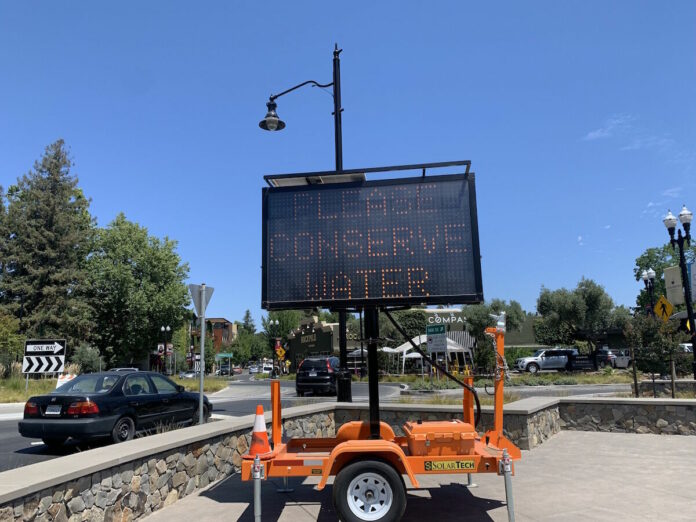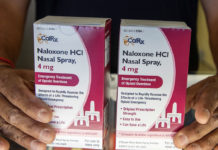At its most recent meeting, the Healdsburg City Council unanimously approved the city’s 2020 Urban Water Management Plan (UWMP), which includes a water shortage contingency plan to address dry years and a recommendation to later update the city’s three stage water shortage ordinance to a six-stage plan that would include restrictions on the issuance of temporary or final occupancy for new development within Healdsburg.
The UWMP is completed every five years and assesses the city’s available water supply and forecasted demands over a 20-year period.
Completion of the UWMP allows the city to access state grants for water related projects such as well drilling. The plan is also vital to city planning and operations because it lays out water demand data and how the city will be able to meet that demand and address water shortages.
In creating the Healdsburg UWMP, city staff looked at Santa Rosa and Ukiah rainfall data from 1911 to 2020.
The average annual rainfall has not significantly changed over a hundred-year period, yet according to Healdsburg Utility Director Terry Crowley, “The difference between a wet year and a dry year is more dramatic. As you get into the ’80s, ’90s and 2000s you start to see more dramatic peaks in rainfall and more dramatic dry years and we see those more frequently and that is what the city should prepare itself for.”
“The city as well as the region needs additional storage of water that can hold water for multiple years,” he said.
Studies of local temperatures also indicate that there will be a hotter climate which will lead to increased irrigation needs in future years.
In order to forecast water demand, city staff looked at citywide population growth. The population forecast assumes a rapid 3% growth between 2020 and 2030 and then 1% growth afterwards.
According to Crowley, the population growth forecasts accounts for the city’s growth management ordinance, Regional Housing Needs Assessment figures and affordable housing and accessory dwelling unit fueled growth.
Incorporating public and council feedback
With this year’s exceptional drought, the UWMP has been a big topic among council members, city staff and Healdsburg residents.
A draft UWMP was first presented to the public during a workshop on May 18. Another public workshop was held with residents and city council members on Aug. 23 and on Sept. 22.
In a review of the draft, city council members and residents felt that the plan was a bit too broad and didn’t adequately consider climate change or multifamily residential water use in its analysis.
“One of the comments we had was to look at multifamily numbers. We’ve gone through the data and came up with an estimate with what we would forecast for multifamily use going forward. Multifamily housing is not have a significant amount of water use in the city. They tend to be very efficient,” Crowley said.
Looking at future water demand and supply
The 2020 UWMP found that in a normal year when all water rights are all available there’s an adequate water supply for the forecasted 25 years ahead. When the city has access to all of its water rights — Gauntlet, Fitch, Dry Creek (seasonal right), Fitch Mountain and Sonoma Water — it has access to a total of around 2,119 million gallons of water a year.
In a single dry year there will be a need to conserve if the city’s water rights are curtailed. Summer months would require a 40% reduction in water usage. If a single dry year were to occur in 2045, it would require a 45% reduction in water usage as the population increases and the demand for water is higher.
Conservation would also be required for multiple dry years as demand outpaces supply. Water usage reduction requirements would range between 20% and 37%.
Tapping into groundwater through aquifer wells and pursuing other supply options such as obtaining a year-round Dry Creek water right or purchasing water from Sonoma Water could help supplement limited water resources during dry spells.
The UWMP does include recommendations to increase the city’s water supply through the construction of groundwater wells and in a separate city council item, the council voted to approve a professional services agreement with GEI Consultants for the study of the feasibility of three potential groundwater well sites.
The consultants will also study documents to determine which identified sites would work best for wells and identify the permits required to continue and conduct exploratory testing of the sites.
According to Patrick Fuss, a city of Healdsburg water/wastewater engineer, the city has identified three potential groundwater well sites: Montage/Passalacqua area, West North Street and the Fitch well field.
Fuss said the city already owns these sites and has rights to the water beneath them. The well construction would run a little over $1 million for each well plus consulting fees.
Three sites with a yield of approximately 100 million gallons per minute could potentially provide 36 gallons per person per day in Healdsburg. And while the wells would provide water, they’d also provide aquifer storage and recovery, which will allow the city to store water underground when surface water is plentiful and use it when surface water is scarce.
As Fuss put it, aquifer storage and recovery wells are sustainable because the water that is taken out is the water that’s being put back into the ground.
Water shortage contingency plan
The UWMP also includes a water shortage contingency plan. The plan includes an obligation to annually present the city council with a water supply update each May and a recommendation to update the city’s water shortage ordinance — also known as the Water Shortage Emergency Plan — from a three stage plan to six stages.
The six stages are compounding, carrying the restrictions of the previous levels forward to higher stages and the stages of conservation would be triggered by water right curtailment (see the sidebar for details on each stage.
The highest stages, five and six, also include restrictions on the issuance of temporary or final occupancy for new development within Healdsburg.
“Under stage five, when a 50% reduction in usage is needed, new development will need to provide an equal amount of conservation (1:1 ratio) before receiving temporary or final occupancy. Under stage six, new development will need to provide a 2:1 ratio of conservation before receiving temporary or final occupancy. Affordable housing would be exempt from this requirement,” according to the agenda item report.
Crowley said since the city’s three stage ordinance is already in place, the city may want to wait to update the ordinance. In any case, any ordinance updates would have to come before the council at a later meeting.
Vice Mayor Ozzy Jimenez thanked city staff for including the multifamily data and said he appreciates the proposed plan to update the water shortage ordinance to six stages.
Councilmember Skylaer Palacios was also thankful that city staff listened to the council’s input.
“I too am really pleased with the changes that were made and feel that the community and council were listened to,” Palacios said.
The water shortage ordinance update will come back to council at a later date.









